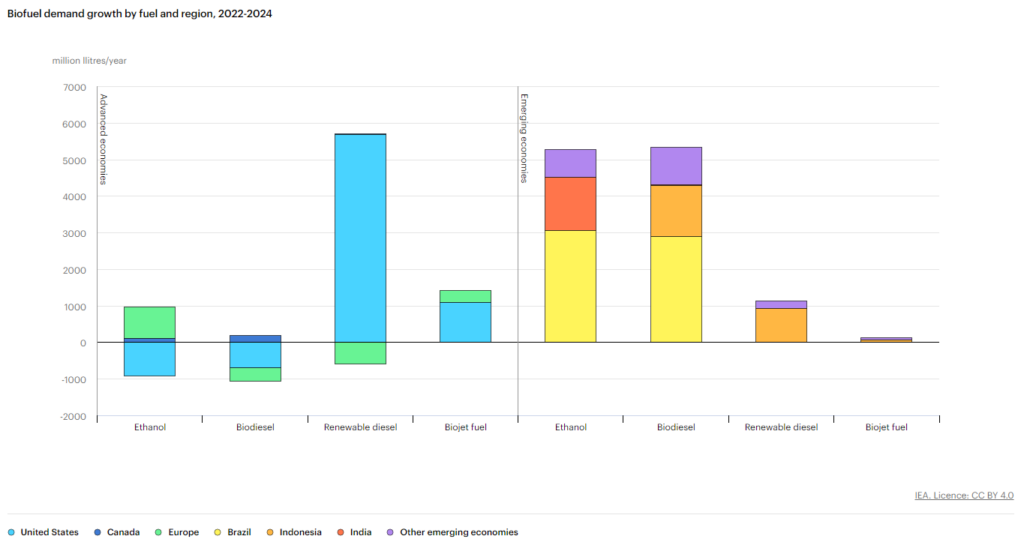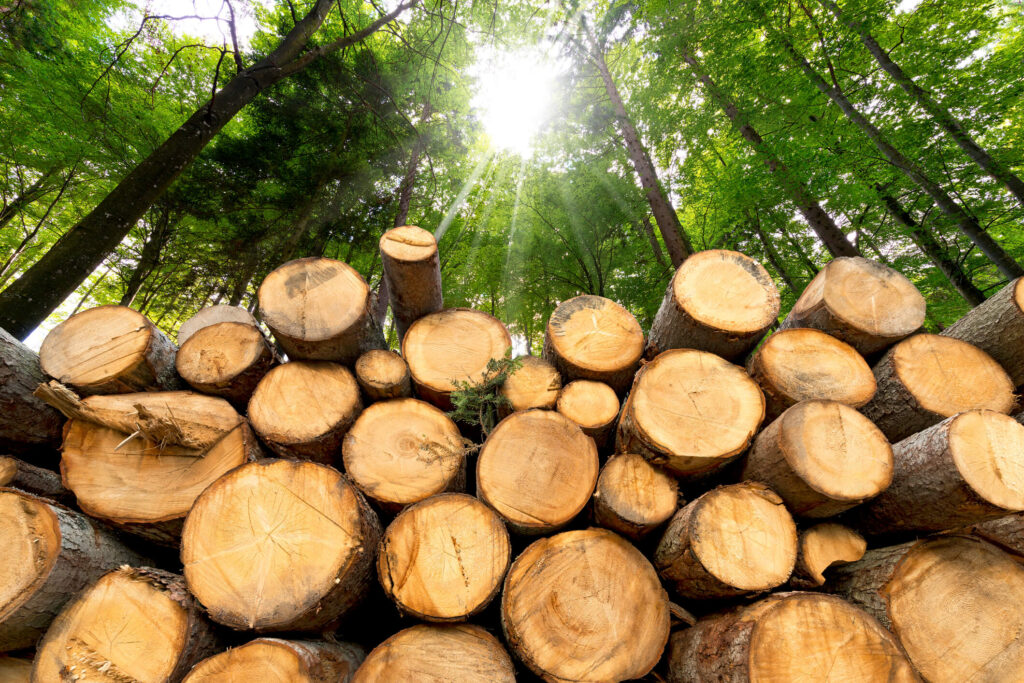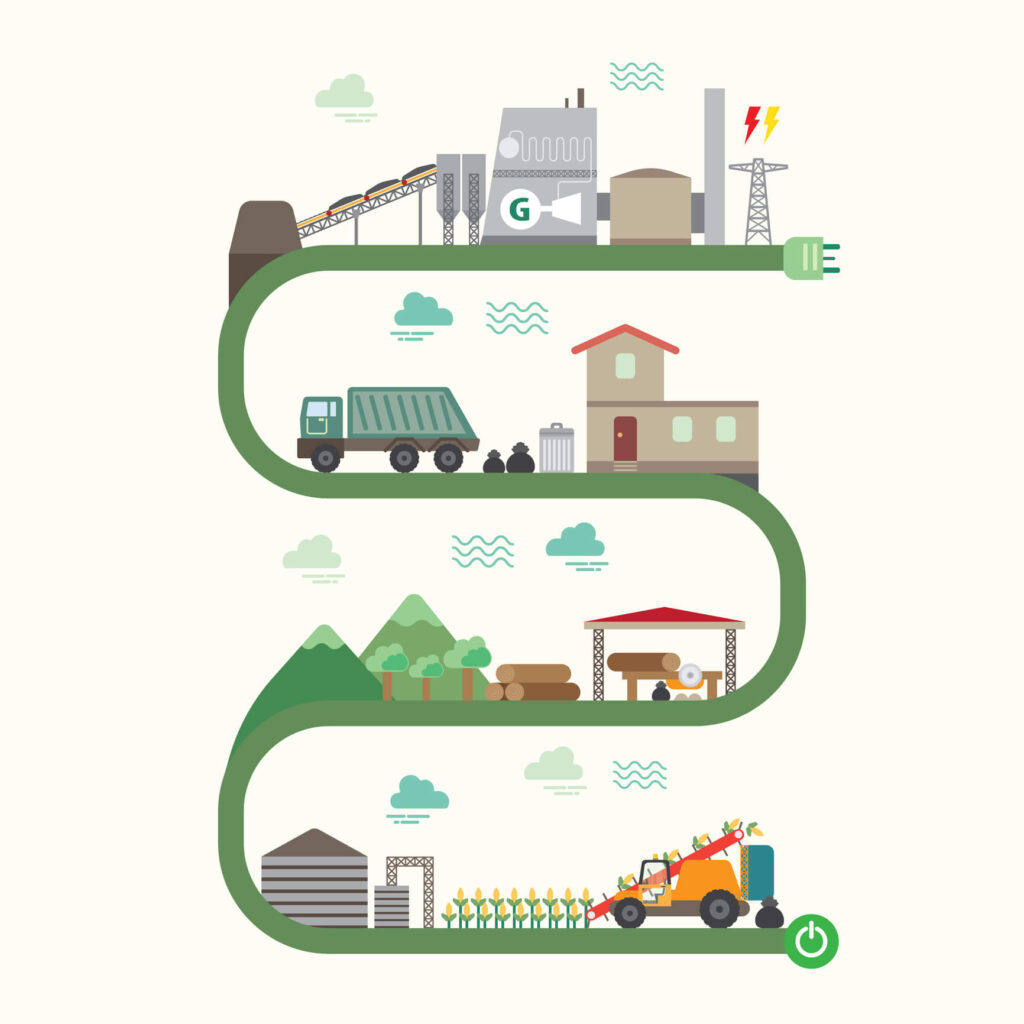The need for clean and renewable energy sources has grown as the globe struggles with climate change and the depletion of fossil fuels. Therefore, the world is seeking alternative energy sources, such as biomass, used to generate bioenergy. This resource provides a flexible and environmentally beneficial substitute for traditional energy sources by utilising the power of organic materials to generate fuel, electricity, and heat.
What is Biomass?
Bioenergy is produced from organic material, known as “biomass”, which describes organic components obtained mostly from plants and animals that are living or have recently been living. Wood, food waste, agricultural leftovers, and even algae fall under this group. Biomass energy has been utilised by humans since the earliest hominids built wood fires for warmth and cooking. Nowadays, it is mainly used for power generation and heating.
According to the International Energy Agency (IEA), between 2010 and 2022, the share of modern bioenergy climbed by almost 3% annually on average, and this trend is continuing. Currently, about 6% of the world’s energy supply and 55% of renewable energy comes from modern bioenergy, making it the largest renewable energy source. With the Net Zero Emissions by 2050 (NZE) Scenario in sight, bioenergy will replace fossil fuels at a rapid rate by 2030.

5 Main Types and Examples of Biomass
1. Wood and Agricultural Products: Biomass derived from forests, agricultural crops, and residues. Examples: Wood logs, wood chips, straw, corn stover.
2. Solid Waste: Organic materials found in municipal solid waste (MSW). Examples: Food scraps, paper, cardboard.
3. Landfill Gas and Biogas: Gases produced from the anaerobic decomposition of organic matter in landfills and digesters. Examples: Methane from landfills, biogas from animal manure.
4. Alcohol Fuels: Fuels derived from the fermentation of sugars found in plants. Examples: Ethanol from corn, biodiesel from soybeans.
5. Aquatic Biomass: Biomass derived from aquatic plants and algae. Examples: Microalgae, seaweed.
Is Biomass a Clean Energy Source?
Since biomass is composed of materials derived from living things, including plants and animals, it makes it organic. Plants, wood, and litter are the most frequent biomass resources used for energy. Therefore, biomass is a clean, renewable energy source, however, depending on how biomass energy is generated it can become a non-renewable energy source. For instance, as per article by National Geographic, biomass feedstocks can become nonrenewable if they are not replenished as quickly as they are used. The energy found in biomass is initially solar energy, which plants obtain through photosynthesis, converting carbon dioxide and water into nutrition (carbohydrates). The plants’ nutrition can be converted, both directly and indirectly, into useful energy. Biomass can be burned directly to provide heat, converted directly to electricity, or processed into biofuel (indirect).
“Biomass is an integral part of Earth’s carbon cycle. The carbon cycle is the process by which carbon is exchanged between all layers of Earth: atmosphere, hydrosphere, biosphere, and lithosphere.”
Biomass Energy, National Geographic Education
The sources, handling, and applications of biomass determine whether or not it qualifies as clean energy. Biomass has the potential to be a cleaner energy source when it is acquired responsibly and utilised effectively. It can, however, exacerbate pollution and environmental deterioration if improperly managed.
Converting Biomass into Bioenergy

Biomass can be converted into bioenergy through various processes:
- Combustion: Direct burning of biomass to produce heat, which can be used to generate electricity.
- Gasification: Converting biomass into syngas (a mixture of carbon monoxide, hydrogen, and methane) through high-temperature processing.
- Pyrolysis: Decomposition of biomass at high temperatures in the absence of oxygen, producing bio-oil, syngas, and charcoal.
- Anaerobic Digestion: Breakdown of organic matter by bacteria in an oxygen-free environment, producing biogas (primarily methane and carbon dioxide).
- Fermentation: Microbial conversion of biomass into alcohols such as ethanol and butanol.
Biomass Power Plants
The steam created during the combustion of plant or animal matter in a combustion chamber powers a biomass power plant. Through the use of biomass generated responsibly, they significantly contribute to lowering dependency on fossil fuels and mitigating climate change. Have a look at the step-by-step guide below to find out how biomass power plants work:
- Preparation and fuel supply: Collection, storage and processing of biomass materials, such as wood chips, agricultural residues, and organic waste to ensure their uniform size and moisture content.
- Fuel feeding system: Conveyors are used to move processed biomass into the combustion chamber. The feeding mechanism regulates biomass feeding rate to sustain ideal combustion conditions.
- Combustion and gasification: The biomass is burned to produce heat, which generates steam. Alternatively, the biomass is converted into syngas (a mixture of gases) through high-temperature processing. Then, the syngas is combusted to produce heat in turbines or engines.
- Steam generation: Boilers and heat exchangers use the heat from combustion or gasification to turn water into high-pressure steam. Turbines attached to electrical generators are powered by this steam.
- Electricity generation: A steam turbine converts thermal energy from steam into mechanical energy which spins a generator to produce an electric current using the energy released by the turbine, which then powers a generator to produce electricity.
- Waste management and recycling: Any other residues from biomass combustion are collected and either disposed of or repurposed for use in agriculture or construction. Also, some of the steam can be recovered at the turbine’s exit and utilised as fuel. This is known as cogeneration.
The Role of Biomass in Renewable Energy
Biomass is a sustainable energy source that can be used to reduce reliance on fossil fuels and decrease greenhouse gas emissions. According to European rules, ‘biomass for energy must be produced, processed and used in a sustainable and efficient way in order to optimise greenhouse gas savings and maintain ecosystem services’. Biomass plays several roles in renewable energy production:

1. Diverse Energy Production
Energy from biomass can be transformed into a variety of forms, such as heat, electricity, and liquid fuels. Its adaptability makes it a useful part of the mix of renewable energy sources. The primary methods of producing bioenergy are as follows:
- Heat Production: Heating homes, businesses, and district heating systems through the direct burning of biomass materials like wood and agricultural waste. As per IEA, buildings can get low-temperature heat from biomass combustion systems, up to 100°C, for heating (e.g. central heating systems of a building or a heating grid) and hot water supply.
- Electricity Generation: Direct combustion, gasification, or anaerobic digestion are the methods used by biomass power plants to generate energy. These plants are capable of producing steady, dependable electricity when used as base-load power sources.
- Biofuels: Processing biomass to produce liquid fuels like ethanol and biodiesel, which can be utilised in transportation and help lessen reliance on fuels derived from petroleum.
2. Waste Management and Utilisation
Biomass energy helps manage and utilise organic waste materials, reducing the amount of waste sent to landfills and minimising methane emissions. By converting agricultural residues, food waste, and other organic by-products into energy, biomass supports a more sustainable waste management system and contributes to a circular economy.
3. Carbon Neutrality and Climate Change Mitigation
Because the carbon dioxide (CO₂) absorbed by plants during their growth balances the CO2 generated during biomass energy’s combustion, biomass energy is frequently referred to as carbon neutral. When compared to fossil fuels, this closed carbon cycle reduces net greenhouse gas emissions, which can help slow down climate change.
4. Rural Development and Economic Benefits
Biomass energy projects can stimulate economic development in rural areas by creating jobs and providing new income streams for farmers and landowners. The production, collection, processing, and transportation of biomass materials contribute to local economies and can lead to infrastructure improvements.
5. Energy Security and Diversification
Biomass improves energy security by diversifying the energy source. It strengthens the energy system’s resilience and lessens reliance on imported fossil fuels. In areas rich in forestry and agricultural resources, biomass can also be a dependable energy source.
6. Supporting Other Renewable Energy Sources
Biomass can complement other renewable energy sources such as wind and solar. It provides a dispatchable and stable energy supply that can fill gaps when intermittent renewable sources are not producing electricity. For example, biomass power plants can operate continuously and adjust their output to match demand, supporting grid stability. A combination of heat and power (cogeneration) can increase the overall system efficiency up to 90%, as stated by the IEA.

Biomass and Its Impact on the Environment
With major advantages for the environment, biomass and bioenergy provide a sustainable energy source. Biomass is regarded as carbon neutral since the CO2 absorbed during its growth balances the CO2 released after combustion. By lowering net greenhouse gas emissions, this helps slow down climate change. Methane emissions and landfill usage are also decreased by utilising organic waste and agricultural residues for energy.
By diversifying the energy supply and lowering dependency on fossil fuels, biomass energy improves energy security, especially in areas with an abundance of biomass resources. Additionally, it encourages rural development by giving farmers and landowners new sources of revenue and employment opportunities. Nevertheless, there are drawbacks to biomass energy, such as the requirement for sustainable resource management to stop deforestation and soil degradation and air pollutants from burning. Food security may also be impacted by the rivalry for land between energy and food crops.
To maximise the benefits of biomass, sustainable sourcing and efficient conversion technologies are essential. Policies supporting sustainable practices and advanced technologies will help address environmental concerns. With careful management, biomass can play a crucial role in the transition to a cleaner, more sustainable energy future, helping combat climate change and promote environmental sustainability.
Recommended products
Guaranteeing the safety of workers in biomass power plants might be challenging. Therefore, to prevent risks of injuries and illnesses, we present some of the supporting Personal Protective Equipment (PPE) below that are suitable for this specific industry.
Combustible Gas Detector, KPS
Combustible gas detector which detects natural gas, methane, ethane, propane, butane, acetone, alcohol, ammonia, steam, carbon monoxide, gasoline, jet fuel, hydrogen solvents, lacquer thinner and naphtha.

Reusable Full Face Mask, 3M
This full facepiece reusable respirator is lightweight, comfortable, and simple to use. When combined with the proper 3MTM particulate filters or cartridges, it can help protect the respiratory system against particulates as well as a range of gases and vapours.

Sensors for combustible gases, FIGARO
This semiconductor-type gas sensor has a long lifespan, low power consumption, and extremely high sensitivity to methane gas.











